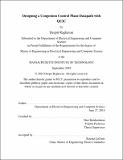Designing a congestion control plane datapath with QUIC
Author(s)
Raghavan, Deepti.
Download1098179741-MIT.pdf (1.072Mb)
Other Contributors
Massachusetts Institute of Technology. Department of Electrical Engineering and Computer Science.
Advisor
Hari Balakrishnan.
Terms of use
Metadata
Show full item recordAbstract
This work explores developing datapaths for the recently proposed Congestion Control Plane (CCP) architecture and uses QUIC as a case study to build and evaluate an example datapath. The CCP moves congestion control logic off of the datapath into a separate agent running in user-space. Now, algorithm developers can write their algorithm using this API and automatically run their algorithm on any CCP enabled datapath, such as QUIC or the Linux kernel. We discuss the necessary features for datapaths to support the user-space CCP agent and develop a library, libccp, for software datapaths. We use QUIC as a case study to design a CCP datapath and evaluate various congestion control algorithms running on top of QUIC. The evaluation focuses on four aspects: (1) Do algorithms written on CCP have the same performance as QUIC algorithms? (2) Do CCP congestion control algorithms behave similarly to their native QUIC counterparts, when run on top of QUIC? (3) How expressive is the CCP API? (4) Does the same algorithm, written through CCP, behave similarly across multiple datapaths? This work reveals that while CCP QUIC algorithms have similar performance for a single flow, their behavior does not exactly match the native QUIC implementations of the same algorithms without modifications. We show that CCP can provide "write once, run anywhere" semantics for congestion control, as multiple algorithms run across QUIC and the Linux kernel exhibit similar behavior. Finally, we evaluate the expressiveness of the CCP API by implementing two algorithms: Hybrid Slow Start and Remy.
Description
This electronic version was submitted by the student author. The certified thesis is available in the Institute Archives and Special Collections. Thesis: M. Eng., Massachusetts Institute of Technology, Department of Electrical Engineering and Computer Science, 2018 Cataloged from student-submitted PDF version of thesis. Includes bibliographical references (pages 65-67).
Date issued
2018Department
Massachusetts Institute of Technology. Department of Electrical Engineering and Computer SciencePublisher
Massachusetts Institute of Technology
Keywords
Electrical Engineering and Computer Science.